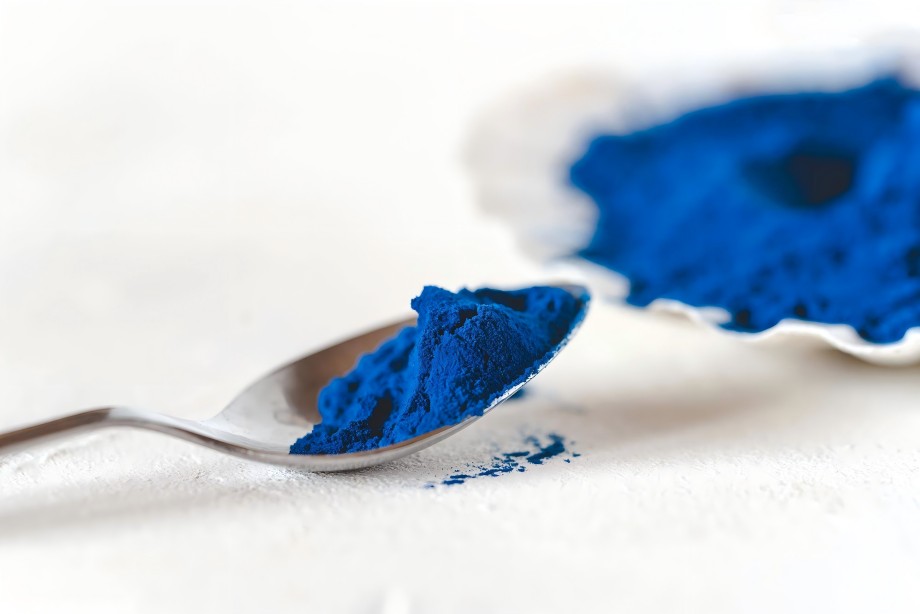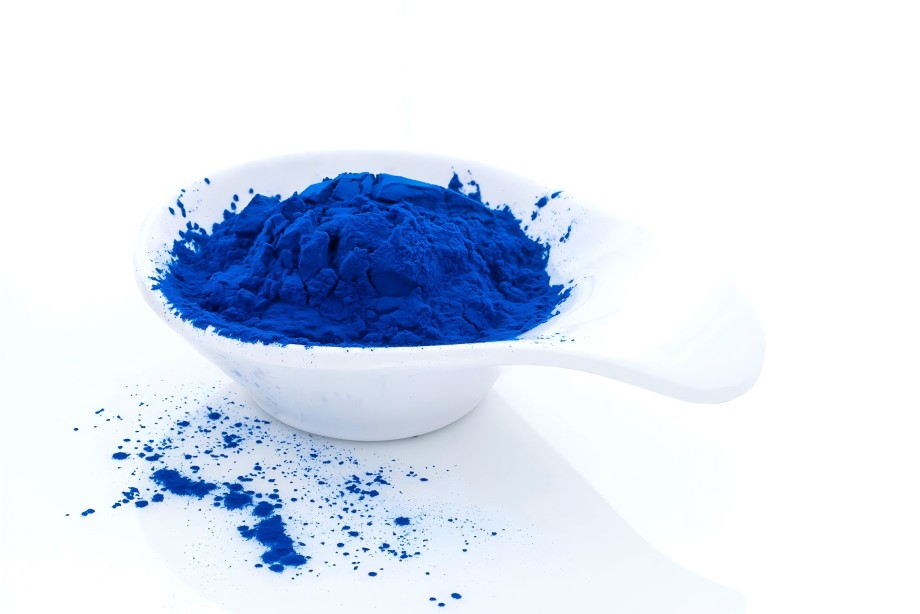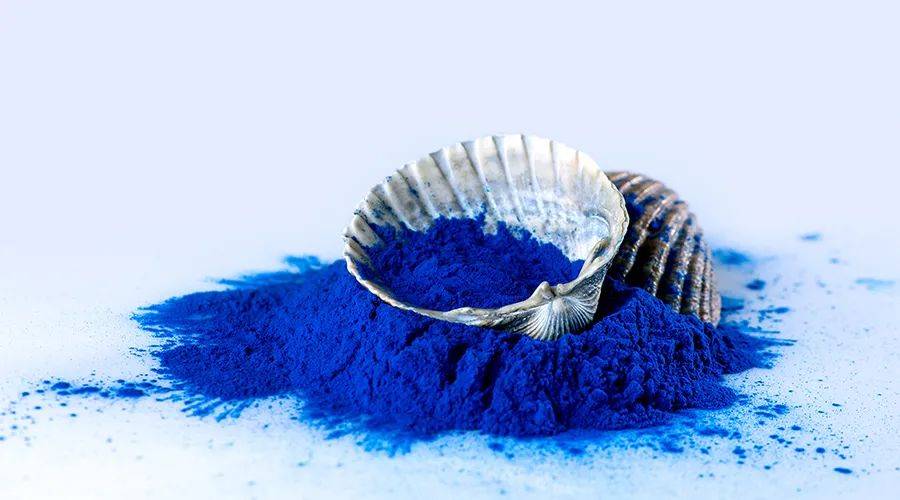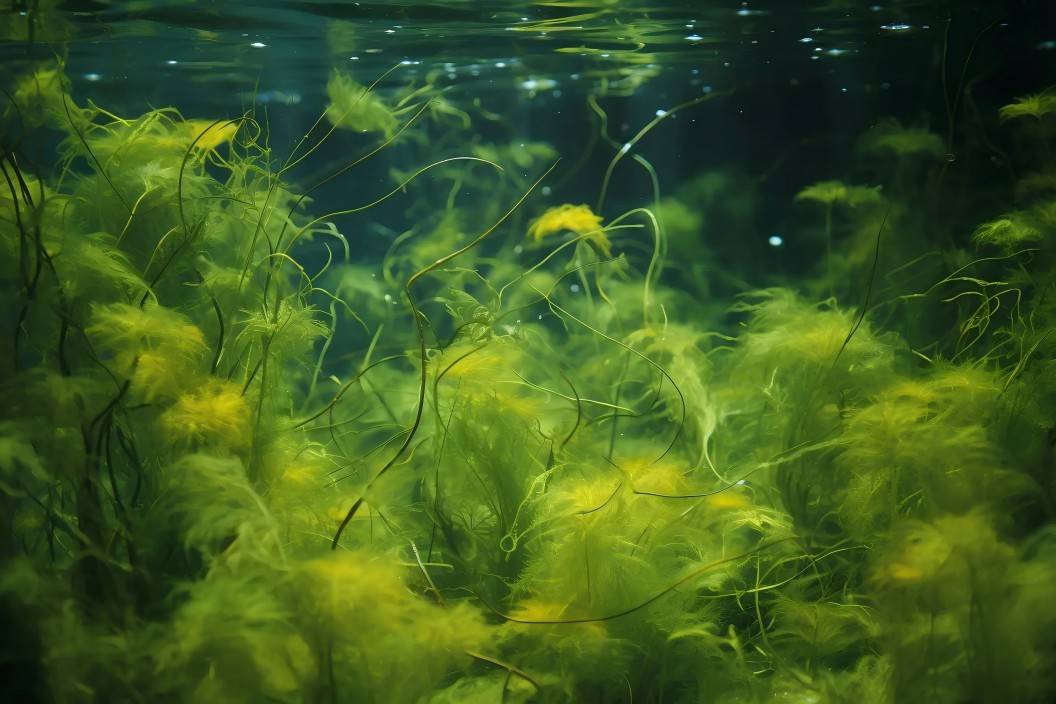What Is the Use of Phycocyanin Powder?
Phycocyanin is a natural pigment protein with a unique structure and remarkable biological activity. It is widely found in algae such as spirulina and anabaena[1], and not only has a charming blue color, but also contains rich nutritional and medicinal value. In the food industry, phycocyanin powder can be used as a natural blue coloring additive to add attractive color to foods. In the pharmaceutical industry, the antioxidant and anti-tumor biological activities of phycocyanin make it a potential therapeutic drug ingredient [2]. However, extraction and purification technology is crucial to the efficient use of phycocyanin. Therefore, in-depth research and optimization of the extraction and purification technology of phycobiliproteins, and the development of new, efficient, economical, and environmentally friendly purification processes, are of great significance for promoting the application of phycobiliproteins in various fields. Most of the existing reviews on the extraction and purification processes of phycobiliproteins introduce a single wall-breaking or extraction technique, lacking an analysis and discussion of the overall process flow [3].
This paper provides a detailed description of the working principles, advantages and disadvantages of various processes. It also discusses the freeze-thaw method and combined processes that are expected to meet the requirements of large-scale industrial production. A comprehensive review of the extraction and purification technology of phycobiliproteins is also provided, analyzing the advantages and disadvantages of various methods and exploring future development trends. The current status of the application of phycocyanin is summarized, pointing out the current deficiencies and methods for further improvement, with the aim of providing a reference for related research and industrial applications.
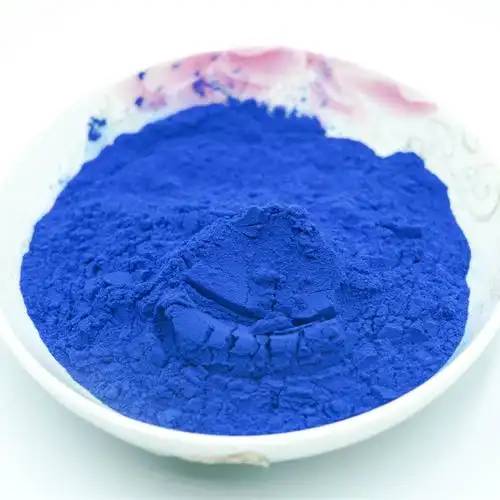
1 Properties of Phycocyanin
Phycocyanins are natural, highly fluorescent proteins that are the main light-harvesting color proteins in marine algae. They can be divided into phycocyanin (PC), phycoerythrin (PE) and allophycocyanin (APC) according to their composition and structure. As shown in Figure 1, these proteins are located on the thylakoid membrane and assembled on the surface of the thylakoid membrane.
Phycocyanin powder is a water-soluble protein that is easily soluble in water but insoluble in alcohol and oil. It contains the phycobilin chromophore and appears as a bright blue powder in solid form. An aqueous solution of phycocyanin has three ultraviolet absorption peaks at 280, 348 and 620 nm. The strongest absorption peak at 620 nm is characteristic of phycocyanin, while the weaker peaks at 280 and 348 nm are attributed to the aromatic amino acid molecules and chromophores on the phycocyanin, respectively. The purity of phycocyanin is determined based on the ratio of absorbance at 620/280 nm (A620/A280), which can be divided into food grade (A620/A280 ≤ 0.7), reagent grade (0.7 ≤ A620/A280 ≤ 3.9) and analytical grade (A620/A280 ≥ 4.0) [4].
The molecule of phycocyanin (Figure 2) is composed of a deprotonated protein and a chromophore with a tetrapyrrole structure linked covalently via a sulfide bond. Phycocyanin contains two different polypeptide subunits, the small relative molecular mass α subunit (12–19 kDa) and the large relative molecular mass β subunit (14–21 kDa). These two subunits can form αβ monomers through intermolecular forces and further aggregate to form polymers (αβ)n. Phycobiliproteins are usually found in trimeric (αβ)3 and (αβ)6 forms and other polymeric forms [5].
2 Extraction and purification of Phycocyanin
How to efficiently and accurately extract phycobiliproteins is a prerequisite for their value. The extraction process of phycobiliproteins is complex and affected by many factors, such as the choice of algae and the means of cell disruption [6]. The efficiency of phycobiliprotein extraction largely depends on the degree of destruction of algal cells. The method of algal cell disruption can largely affect the efficiency and purity of phycobiliprotein extraction. The process of physically, chemically or enzymatically breaking the cell walls and cell membranes of suitable algae to release phycobiliproteins from the cells is called crude phycobiliprotein extraction.
2.1 Crude phycobiliprotein extraction
At present, there are many methods that can isolate phycocyanin from complex algae cells. These crude extraction processes are often used as pretreatment for the isolation and purification of phycobiliproteins, including traditional methods such as grinding, high-pressure homogenization, and freeze-thawing, as well as the emerging ultrasonic method. Different processes have different working principles, advantages and disadvantages, and therefore suitable application scenarios are also different (Table 1). In order to obtain a more cost-effective extraction process, the principles, advantages and disadvantages of various methods are explored in depth.
Chen Yu [11] compared the results through single-factor experiments and finally determined that the combination of the freeze-thaw method and high-pressure homogenization can effectively avoid the problem of phycobiliprotein denaturation caused by the use of high-pressure homogenization alone. Because high-pressure extraction technology can efficiently process large amounts of material at one time, it is often combined with other temperature-controlled processes for the large-scale crushing of spirulina in factories. Hou Zhaoquan et al. [12] conducted an in-depth study on the effect of the number of cycles on the yield and purity of phycobiliproteins extracted from spirulina, and found that the best condition was 4 freeze-thaw cycles.
SARAN et al. [13] used the model of Spirulina platensis to explore the effects of citrate (pH=5.0), acetate buffer (pH=6.0) and sodium phosphate buffer (pH=7.0) as solvents on the extraction rate of phycobiliproteins. The study found that the sodium phosphate buffer had the best extraction effect, with an extraction rate of 146.0 mg/g of phycobiliprotein. Yu Xiaolei [14] extracted phycobiliprotein with the aid of ultrasound technology, effectively reducing the working time. It was found that ultrasound technology has the characteristics of good reproducibility, low solvent consumption and low temperature operation, and can maintain the activity of phycobiliprotein to the greatest extent.
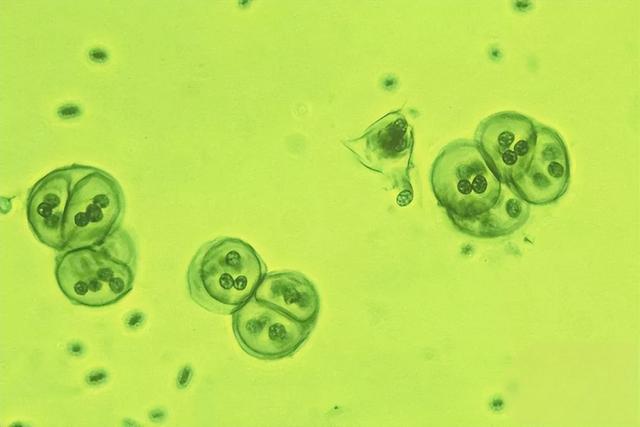
2.2 Purification of phycobiliprotein
The crude extract obtained by the above series of operations contains a large amount of impurity proteins. However, for some specific industries, the raw materials of phycocyanin used must be above reagent grade. Therefore, after pretreatment of algae, the crude extract needs to be further separated and purified to obtain phycocyanin of higher purity. At present, the commonly used methods for purifying phycobiliproteins include chromatography, two-phase extraction, three-phase extraction, and activated carbon adsorption.
2.2.1 Chromatography
As the most commonly used method for purifying proteins, chromatography has now basically met the requirements for industrial production of purified crude spirulina extract. AMARANTE et al. [20] developed a one-step purification process for extracting phycocyanin from spirulina by combining pH gradient elution with ion chromatography. This process was used to obtain phycocyanin with purities of 4.2 and 3.5, with recovery rates of 32.6% and 49.5%, respectively. Gel filtration chromatography can separate substances according to their relative molecular mass. Most of the packing materials are inert materials with a porous network structure. Hydroxyapatite (HAP) is a natural calcium phosphate crystal composed of calcium and phosphorus. It has calcium ions and phosphate ions on the surface, and the calcium ions can ion-exchange with phycocyanin and the phosphate ions can adsorb with phycocyanin [21]. HAP also has high alkali resistance and a unique separation mechanism, and is the only inorganic chromatography filler that can be directly used for protein and nucleic acid purification. In addition, HAP can simultaneously separate and purify phycobiliproteins and other phycobiliproteins. Therefore, HAP is often used as a filler in affinity chromatography for the simultaneous separation and purification of the two proteins [22].
2.2.2 Two-phase solvent extraction
In addition to using a single aqueous solution to extract phycocyanin, there is also a special aqueous solution extraction method called two-phase solvent extraction. In general, aqueous extraction refers to the direct use of a single aqueous solution as a solvent to dissolve and extract the target substance. Although the two-phase solvent extraction method also takes place in an aqueous environment, it uses a special system with two components that form immiscible aqueous phases. Common two-phase systems are shown in Table 4 [23]. The determination of the two-phase system usually depends on the partition coefficient (Kp) of the protein. Compared with other separation techniques, the two-phase solvent extraction method has the advantages of high biocompatibility, mild operating conditions, fast extraction rate and suitability for scale-up
processes, and is widely used in the extraction of phycocyanin. CHETHANA et al. [24] conducted an in-depth study on the process of extracting and purifying phycocyanin using two-phase solvent extraction technology, and obtained phycocyanin with a purity of 4.32 and a recovery rate of 79% under standardized conditions.
2.2.3 Three-phase extraction method
At the end of the 20th century, PANADARE et al. [25] proposed the three-phase extraction method (TPP), which can be used to extract and purify proteins simply and quickly. Compared with traditional methods, TPP, as an emerging non-chromatographic biological separation technique, can overcome many of the associated limitations.
When the crude extract of phycocyanin is mixed evenly with an appropriate amount of buffer solution and organic reagent, the mixture can form three phases. The upper organic phase can collect pigments and lipids, the middle phase contains precipitates such as proteins, and the lower aqueous phase contains polar components such as sugars. Compared with other organic reagents, tert-butanol has a high boiling point, is less flammable, and has a special branched chain structure that prevents protein denaturation. Therefore, tert-butanol is often used as an organic reagent in the TPP technique for the extraction and purification of phycocyanin [26]. As a simple, effective, relatively inexpensive and promising extraction technique, TPP has been used in upstream and downstream biomolecule purification processes. At the same time, this technology is more environmentally friendly and can be used for large-scale preparation. It is a new purification technology with great development potential.
2.2.4 Ultrafiltration
The principle of ultrafiltration is to use an ultrafiltration membrane with a specific pore size to separate and purify substances based on differences in molecular size and shape. When purifying phycocyanin, the phycobiliprotein-containing solution needs to be pretreated first, such as removing impurities, adjusting the pH and ionic strength of the solution, etc., to optimize the ultrafiltration effect. An ultrafiltration membrane with a pore size smaller than the molecular size of phycocyanin is selected to ensure that the phycobiliproteins are retained on one side of the membrane, while smaller impurity molecules and solvents can pass through the membrane.
During ultrafiltration, a certain pressure is applied or centrifugation is used to force the solution through the ultrafiltration membrane.
Phycocyanins are retained on the concentrated side, while impurities and small molecules pass through the membrane and enter the permeate side, thus achieving preliminary separation and purification. Ultrafiltration has the advantages of being simple to operate, being able to be applied on a large scale, and being able to maintain protein activity relatively well. However, there are also some limitations, such as the decrease in separation efficiency due to membrane contamination and the possible unsatisfactory separation effect on impurities with similar relative molecular mass [27]. In short, ultrafiltration is an effective method for the purification of phycobiliproteins, but in practical applications, various factors need to be considered comprehensively, and it is often necessary to combine with other processes to obtain high-quality purified products.
2.2.5 Activated carbon adsorption
Activated carbon is an adsorbent with strong adsorption capacity obtained through artificial processing. According to its shape, it can be divided into powdered activated carbon with a diameter of less than 0.18 mm and granular activated carbon with a diameter of >0.18 mm. Activated carbon has a developed pore structure. Pores with an aperture of more than 50 mm are called macropores, pores with an aperture of less than 2 mm are called micropores, and pores between the two are called mesopores. Among them, micropores are also called adsorption pores, which are the main adsorption pores of activated carbon and play a decisive role in the adsorption performance of activated carbon [28]. Activated carbon has shown good application value in environmental aspects such as sewage treatment and formaldehyde removal. In recent years, it has been found that activated carbon has potential application value in the separation and purification of phycocyanin [29].
2.2.6 Free-flowing electrophoresis
Free-flow electrophoresis is an important electrophoresis technique for the continuous separation and purification of macromolecules such as proteins under mild conditions, which can well maintain the integrity and biological activity of the target structure. The working principle of this technique is shown in Figure 3. The separation chamber consists of two parallel plates that are very close together, which form a very thin separation chamber. When the buffer enters the separation chamber through the pressure pump, a stable laminar flow is formed. When there is no electric field, the crude extract containing the target protein enters the separation chamber and flows with the buffer to the outlet end. When an electric field is applied perpendicular to the direction of the buffer flow, the charged particles in the crude extract migrate at different speeds due to electrophoresis, resulting in the components moving different distances in the separation chamber and being collected at different positions at the outlet end. This achieves the separation and purification of the target protein.
Traditional free-flow electrophoresis devices have a complex structure, few buffer inlets, and a long distance from the entrance to the separation chamber before a stable laminar flow can be established, resulting in poor separation and purification. In recent years, a large number of improvements have been made to the free-flow device, and a gas-liquid buffer device and a gravity-induced equilibrium collector have been developed to form laminar flow in the separation chamber, solving the problem of the buffer fluid having to travel a long distance into the separation chamber before laminar flow can be formed. This device has now been used to separate and purify organic matter, cells and proteins in natural biological samples.
In order to further improve the performance of the free-flow electrophoresis device, YANG et al. [30] improved the injection method, resulting in the emerging free-flow electrophoresis device structure. The introduction of sheath flow injection technology simplifies the operation process, effectively improves the separation efficiency of proteins, and avoids the contamination of the gas-liquid buffer caused by the sample in the traditional device. The team used the improved sheath flow injection method to separate and purify phycocyanin from crude spirulina extract. The purity of the obtained phycobiliprotein reached 4.60, and the recovery rate was 79% [31]. The successful application of this technology provides a new means for the large-scale production of analytical-grade phycocyanin.
3 Combined extraction and purification process
In practical applications, the extraction and purification of phycocyanin cannot obtain high-purity phycocyanin in a single process. Therefore, it is often necessary to combine two or more process structures to obtain high-purity phycocyanin with high yields. Because the freeze-thaw method is simple to operate, low-cost and can be applied on a large scale, it is often used in the current process for the extraction and purification of phycocyanin to pretreat phycocyanin and obtain a crude phycocyanin extract. The crude phycocyanin extract obtained by the freeze-thaw method has low purity and requires subsequent purification to further improve the purity of the phycocyanin.
3.1 Combination of salting-out and other methods
The crude phycocyanin solution obtained by the freeze-thaw method has low purity and requires subsequent treatment to further improve the purity of the phycocyanin. Salting-out is a traditional protein purification method. The current process is relatively mature, the source of materials is relatively wide, the operation is simple and it is easy to achieve industrial production. Therefore, when treating the crude phycocyanin solution obtained by the freeze-thaw method, combining salting-out with other methods in the process can greatly improve the purity and recovery rate of phycocyanin.
3. 1. 1 Purification of crude liquid by salting-out method combined with chromatography
After the researchers treated the cyanobacteria in Chaohu Lake with freeze-thawing, they obtained a crude extract of phycocyanin by two-step salting-out method, and then purified the phycocyanin by gel chromatography, ion exchange chromatography and affinity chromatography respectively [15,32-33]. First, a single-factor experiment was used to determine that 1.0 and 1.8 mol/L (NH4)2SO4 were added in one-step and two-step salting-out, respectively, to obtain a crude phycobiliprotein extract with a purity of 2.40. Subsequently, the crude extract was purified by the three chromatographic methods. Among them, the recovery rate of gel chromatography is high, and ion chromatography is more economical. It is worth mentioning that affinity chromatography can purify simultaneously to obtain reagent-grade phycocyanin and phycocyanin. The combination of salting-out and affinity chromatography provides a new technical idea for the simultaneous separation and purification of phycocyanin and phycocyanin, which will play a positive guiding role in future scale-up production.
3. 1.2 Purification of crude liquid by salting-out combined with extraction
Yuan Mengyuan et al. [34] conducted an in-depth study on the sequential operation order of the salting-out method and the two-phase liquid process. First, the effects of three salting-out agents, ammonium sulfate, ammonium citrate and potassium citrate, were compared in the crude extraction of phycocyanin, and ammonium sulfate was determined to be the best salting-out agent. Phycobiliproteins with a purity of 3.0 or higher were obtained by two-step salting-out combined with two-phase liquid extraction. The order of the salting-out method and the two-phase solvent extraction method in the process was also explored [35]. The results showed that polyethylene glycol was difficult to remove from the phycobiliprotein extract, so it was determined that the process was first extracted by salting-out, and finally purified by two-phase solvent extraction. WANG et al. [36] changed the concentration of the salting-out agent and the system of the two-phase extraction method to obtain a fluorescent reagent-grade phycobiliprotein with a purity of 4.60 and a recovery rate of 91%. In addition to purifying phycocyanin by combining them with a two-phase solvent extraction method, Wang Xueying [17] obtained phycocyanin with a purity of 3.46 by combining salting out with a three-phase solvent extraction system, with a recovery rate of 52.41% (Table 6). When the process was scaled up 10 times, the extraction system remained stable, providing a rapid, gentle and efficient route for industrial-scale purification of phycocyanin.
3.2 Activated carbon process
The chemical method requires the addition of chemical reagents to the system, which can easily lead to irreversible denaturation of the protein and also increase the difficulty of purification in subsequent processes. Therefore, the development of a combined physical method will provide a new idea for improving the purity and yield of phycobiliproteins. Activated carbon is a more cost-effective purification process, and combining it with other processes can help further improve the purity of phycocyanin, providing a more economical process idea for large-scale industrial production. After screening the purification effects of four types of activated carbon: coconut shell, fruit shell, wood and coal, with different particle sizes (100, 200, 300, 400 and 500 mesh), and considering both the purity and recovery rate of phycocyanin, it was concluded that the adsorption experiment using 400-500 mesh powdered coal-based activated carbon gave the best results [37].
Sheng Jingmeng et al. [38] found that the purity of phycocyanin obtained by a combined activated carbon and extraction process was greatly improved compared to a single extraction process, increasing from 1.06 to 3.46. The purity of phycocyanin obtained by a combined activated carbon and salting-out process was not only much higher than that obtained by a single salting-out process, but the recovery rate also increased from 67% to 72% [37]. Compared with the combined salting-out and extraction method, the combined activated carbon and chromatography method is more suitable for the industrial production of reagent-grade phycocyanin [39]. After obtaining pharmaceutical-grade phycobiliproteins by the freeze-thaw method and powdered activated carbon adsorption method, the phycocyanin extract was further concentrated using ultrafiltration, and finally purified by HAP chromatography to increase the purity of the phycocyanin to the reagent level (Table 7). This process route provides the possibility for the industrial production of reagent-grade phycocyanin, but one-step HAP chromatography is not sufficient to completely remove small molecular impurities and foreign proteins from the phycocyanin solution.
4 Applications of phycocyanin
Phycocyanin contains 17 essential and non-essential amino acids, except tryptophan, and is an ideal protein source for humans. Due to its unique physicochemical properties and biological activity, phycocyanin has a good performance in the fields of food, medicine and cosmetics.
4.1 Food field
Blue is an indispensable color in food. Currently, natural blue substances are relatively scarce, and China allows the use of synthetic blue pigments in food. Phycocyanin powder is non-toxic and has good water solubility, so it is used as a natural food coloring agent instead of synthetic pigments. It meets consumers' demand for natural and harmless food and is therefore attracting widespread attention in the food industry. However, it is difficult for phycocyanin to maintain a stable state for a long time in aqueous or phosphate solutions. As the phycocyanin subunit continues to depolymerize, the aggregated form of phycocyanin will gradually change from (αβ)6 to αβ monomers, which will lead to a deviation in color. In recent years, researchers have improved the light and heat stability of phycocyanin by combining it with polysaccharides, adding whey protein or forming micelles.

The antibacterial and antioxidant properties of phycocyanin make it popular in the food packaging industry. GOLMAKANI et al. [47] used electrospinning to obtain nanofibers of zein protein loaded with phycocyanin. The chemical structure and thermal stability of GSPE obtained by electrospinning technology were significantly enhanced, and its good bactericidal and antioxidant properties were outstandingly used in the field of active food packaging.
4.2 Pharmaceutical field
In addition to its blue luster, phycocyanins are widely used in the medical field due to their antioxidant, antitumor, hemostatic and natural fluorescent properties.
The high biocompatibility and photodynamic properties of phycocyanin powder have led to its widespread use in the study of photosensitizers. SHEN et al. [48] extracted selenium-rich phycocyanin (Se-PC) from selenium-rich Spirulina platensis, which was shown to reduce the survival rate of mouse lung cancer cells, providing a potentially effective photosensitizer for the treatment of lung cancer (Figure 5). To improve the specificity of phycocyanin against cancer cells, it is often made into nanoparticles with different properties. Although this can improve the expression of the photosensitizer in cells, there have been few reports on photosensitizers that target the organelle environment of cancer cells. In addition to using phycocyanin as the main body to kill cancer cells through photodynamic therapy, combination therapy is also a common approach to cancer cell treatment. Compared with the effect of a single original drug, the combination of phycocyanin greatly alleviates the damage of the original drug to the body and enhances the apoptosis effect of cancer cells.
Alginin powder can emit a strong fluorescent signal after absorbing excitation light. Compared with other natural fluorescent agents, it has a higher quantum yield, a larger Stokes shift and a higher molar extinction coefficient. Therefore, it is also used in the production of fluorescent probes to further realize in situ visualization fluorescence imaging in cells or biological tissues, providing new ideas for environmental testing and disease diagnosis. HOU et al. [52] developed a fluorescent probe for the detection of mercury ions using phycocyanin as a raw material. The probe showed good results in the detection of mercury ions in seafood (oysters and catfish), providing a new means for the detection of environmental pollutants. SHAO et al. [53] reported a phycobiliprotein-carbon dot nano-probe capable of ratiometric fluorescence measurement of peroxynitrite, providing a new solution for exploring the pathogenesis of diseases such as cancer and neurodegeneration. Although the development of phycobiliprotein probes has seen some progress in recent years, the number of research results is far lower than that of phycocyanin and other phycocyanin probes, which may be attributed to the fact that the light and thermal stability of phycocyanin has not been effectively solved.
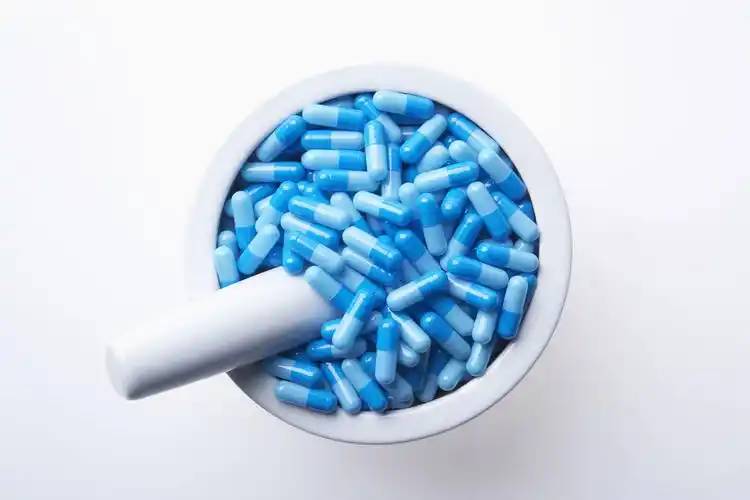
Non-toxic natural materials with hemostatic properties are at the heart of wound dressing design. AZAZA et al. [54] used substances such as chitosan and phycocyanin to synthesize a composite hydrogel HG-20, which showed certain ability to promote wound healing in rat experiments, providing a new research idea for cost-effective wound dressings.
In addition to the above-mentioned applications in the pharmaceutical field, the good performance of phycocyanin in cell models for the protection of the reproductive system, anti-diabetes and prevention of colon cancer has made it widely used in the production of health care drugs [55-56].
4.3 Cosmetics
Some synthetic additives in cosmetics and skin care products often come into contact with human skin, causing allergies in some users. As people become increasingly concerned about the health effects of chemicals used in cosmetics, products derived from natural sources are becoming more and more popular around the world. As a natural source of pigments, phycocyanin powder is also considered an attractive alternative for cosmetic formulations due to its antioxidant and anti-inflammatory properties. C-phycocyanin extracted from spirulina has an anti-melanin effect by regulating the expression of tyrosinase in the mouse melanoma cell (B16F10) cell line, so it is added to the cosmetics industry as a skin whitening agent [57]. KRASEASINTRA et al. [58] used natural phycocyanin as a hair dye to avoid the problem of users' allergies caused by chemical hair dyes. ADLI et al. [59] used solvent casting to process a composite material of poly(lactic acid), phycocyanin and alginate into a non-toxic and antioxidant cosmetic patch. The cosmetic patch made from this material is biodegradable, avoiding the non-biodegradability of traditional cosmetic patches and the resulting environmental pollution.
4.4 Other fields
Phycocyanin is green and inexpensive, and it not only shows good application in the fields of food, medicine and cosmetics, but also in the agricultural field. VARIA et al. [60] used spirulina extract rich in phycocyanin as a biostimulant for hydroponic lettuce cultivation. The growth cycle of lettuce was shortened by 6 d, and the yield increased by 12.5%. These data show that phycocyanin powder is expected to become an economical and environmentally friendly biostimulant for the growth and development of crops.
5 Conclusion and outlook
As a natural pigment protein with important biological activity and application value, the continuous development of the extraction and purification process of phycocyanin powder provides a guarantee for its application in the fields of food, medicine and cosmetics. Through the research and comparison of various extraction methods and purification techniques, it is found that although physical extraction is simple to operate, the extraction efficiency is low; chemical methods can improve the extraction rate, but may affect the protein structure and activity; biological methods are environmentally friendly and gentle, but the cost is high. In terms of purification, chromatography has become the mainstream method due to its high efficiency and selectivity, but it also needs to be combined with other techniques to further improve purity and recovery. The appropriate extraction and purification method needs to be selected based on multiple factors such as the characteristics of the raw material, the target purity, and the cost.
The extraction and purification technology of phycocyanin is expected to achieve breakthroughs in the following aspects: At present, the algae selected for phycocyanin are relatively single, and the extraction and purification process of phycocyanin suitable for other algae can be explored in the future; a more efficient, green and low-cost cell wall-breaking method can be developed, and a new combined phycobiliprotein extraction and purification process can be used to achieve a more efficient and high-purity purification effect while reducing operating costs.
In addition, with in-depth research on the biological activity and function of phycocyanin, their applications in the fields of medicine, food, and cosmetics will continue to expand. Some of the deficiencies of phycocyanin need to be improved, for example: the poor photothermal and chemical stability of phycocyanin limits their development as photosensitizers and fluorescent probes; phycocyanin will undergo depolymerization in aqueous solutions over time, resulting in color deviations in the product.
How to obtain high-purity, highly stable and diverse phycocyanin economically and greenly will be the focus of future research. It is believed that through continuous research and innovation, stronger support will be provided for the large-scale production and application of phycobiliproteins, bringing greater economic and social benefits to related industries.
Reference:
[1] ZHONG X , WANG L.Research on the cultivation and culture technology of marine spirulina[J] . Journal of Aquaculture, 2020 , 41( 1): 58-60 .
[2] SPILLERT C R, PELOSI M A, PARMER L P, et al. A peroxide-induced inflammation model for drug testing[J] . Agents Actions, 1987, 21(3 - 4): 297-298.
[3] FU L L, NA R,GUO J F,et al.Research progress on the extraction and purification of phycocyanin from spirulina[J] . Biotechnology Bulletin, 2016 , 32( 1): 65-68 .
[4] CHEW K W, CHIA S R, KRISHNAMOORTHY R, et al. Liquid biphasic flotation for the purification of C-phycocyanin from spirulina platensis microalga[J] . Bioresource Technology, 2019, 288: 121519-121526.
[5] SHAO M F, ZHAO N, LIU B,et al.Progress of process technology for the preparation of algal blue protein on a large scale[J] . Food and Fermentation Industries, 2013 , 39(2): 135-139 .
[6] ZENG J H, YANG Y, SHI Y G,et al.Research progress on mild disruption technology of microalgae for functional protein releasing[J] . Science and Technology of Food Industry, 2018 , 39( 17): 319-327 .
[7] FAIETA M, COLARUOTOLO L A , HUYNH L, et al. High-pressure processing (HPP) of phycocyanin extract solutions: Enhancing stability through molecular interactions[J] . LWT-Food Science and Technology, 2024, 198(15): 115965-115975.
[8] MAO M X, HAN G X, ZHAO Y L, et al. A review of phycocyanin: Production, extraction, stability and food applications[J]. International Journal of Biological Macromolecules, 2024, 280(3): 135860 -135873.
[9] MARTINEZ J E, EATARRON E V, ESCALANTE F M. Comparative study of the efficiency of additives in the extraction of phycocyanin-C from Arthrospira maxima using ultrasonication[J].Molecules, 2023, 28(1): 334-344.
[10] WANG Z W, ZHOU J W, LI J H, et al. Rational design of key enzymes to efficiently synthesize phycocyanobilin in Escherichia coli[J] . Biomolecules, 2024, 14(3) : 301-316.
[11] CHEN Y. Research of brokening methods of phycocyanin extraction from blue algae in Lake Chaohu[D] . Hefei : Hefei University of Technology, 2015 .
[12] HOU Z Q, LIU X Y, SHI C , et al . The research of extraction procedure by using method of freezing-thawing and ultrasonic broken process to extract phycocyanin from spirulina algae[J] . Journal of Inner Mongolia Agricultural University, 2017 , 38(2): 69-75 .
[13] SARAN S, PURI N K, JASUJA N D, et al. Optimization, purification and characterization of phycocyanin from Spirulina platensis[J] . International Journal of Applied and Pure Science and Agriculture , 2016, 2(3): 15-20.
[14] YU X L . Study on extraction and purification of phycocyanin from spirulina platensis[D] . Zhenjiang: Jiangsu University, 2023 .
[15] SU Y . Study on Purification of phycocyanin by multiple column chromatography[D] . Hefei : Hefei University of Technology, 2018 .
[16] FABRE J F, NIANGORAN N, GAIGNARD C, et al. Extraction, purification and stability of C-phycocyanin from Arthrospira platensis[J] . European Food Research and Technology, 2022, 248: 1583 -1599.
[17] WANG X Y. Application of three-phase partitioning in purification of C-phycocynin[D] . Harbing : Harbin Institute of Technology, 2021 .
[18] ZHANG X M. Comparison of powdery activated carbon adsorption combined with column chromatography and ultrafiltration for purifying phycocyanin[D] . Hefei : Hefei University of Technology, 2018 .
[19] CHEN S, PALMER J F, ZHANG W, et al. A simple preparative free-flow electrophoresis joined with gratis gravity: I. Gas cushion injector and self-balance collector instead of multiple channel pump[J] . Electrophoresis, 2010, 30(11): 1998-2007.
[20] AMARANTE M C A D, JÚNIOR L C S C, SALA L, et al. Analytical grade C-phycocyanin obtained by a single-step purification process[J] . Process Biochemistry, 2020, 90: 215-222.
[21] CAI C, WU L, LI C X, et al. Purification, crystallization and preliminary X-ray analysis of phycocyanin and phycoerythrin from Porphyra yezoensis Ueda[J] . Acta Crystallogr Sect F-Struct Biol Cryst Commun, 2011, 67(5): 579-583.
[22] YU L Y. Progress of research on the nature and extraction technology of algal blue protein[J] . The Light AND Textile Industries of Fujian , 2020 , 5 : 46-51 .
[23] SALABAT A, MOGHADAM S T, FAR M R. Liquid-liquid equilibria of aqueous two-phase systems composed of TritonX-100 and sodium citrate or magnesium sulfate salts[J] . Calphad, 2010, 34(1): 81-83.
[24] CHETHANA S, NAYAK C A, MADHUSUDHAN M C, et al. Single step aqueous two-phase extraction for downstream processing of C- phycocyanin from Spirulina platensis[J] . Journal of Food Science and Technology, 2015, 52(4): 2415 -2421.
[25] PANADARE D C, RATHOD V K. Three phase partitioning for extraction of oil: A review[J] . Trends in Food Science and Technology, 2017,68: 145-151.
[26] CHEW K W, LING T C, SHOW P L. Recent developments and applications of three-phase partitioning for the recovery of proteins[J] . Separation and Purification Reviews, 2019, 48(1): 52-64.
[27] PORAV A S, BOCNEAL M, FLMA A, et al. Sequential aqueous two-phase system for simultaneous purification of cyanobacterial phycobiliproteins[J] . Bioresource Technology, 2020, 315: 123794-123803.
[28] WANG W T, LAI X T, HE X B , et al . Degradation of dye wastewater by reductive organic acids coupled with ferric supported activated carbon fiber[J] . Fine Chemicals , 2021 , 38(5): 1023-1029 .
[29] DING N N, LIANG J H, WU L, et al . Preparation of biochars and its applications in adsorption[J] . Analysis and Testing Technology and Instruments, 2022 , 28(4): 363-374 .
[30] YANG Y, KONG F Z, LIU J, et al. Enhancing resolution of free-flow zone electrophoresis via a simple sheath-flow sample injection[J] . Electrophoresis, 2016, 37(14): 1992-1997.
[31] YANG Y.Methodological research about fast separation and purification of phycocyanin via free flow electrophoresis[D] . Guangzhou : South China University of Technology, 2016 .
[32] SU Y,ZHANG F Y,SHE J W, et al . Purification of phycocyanin from Chaohu Cyanobacteria by fractional salting out and two steps column chromatography[J] . Journal of Anhui Agricultural University, 2018 , 45(3): 487-491 .
[33] WU K, ZHANG F Y, ZHAO B B, et al . Optimization and mechanism analysis of purification of phycocyanin by column chromatography[J] . Hans Journal of Biomedicine , 2019 , 9(2): 81-88 .
[34] YUAN M Y, ZHANG F Y, SHENG J M, et al . Influences of different salting-out agents on effect of phycocyanin from blue algae[J] . Food Science and Technology, 2016 , 41(5): 267-272 .
[35] YUAN M Y. The study of extraction of phycocyanin by salting-out and aqueous two-phase system from cyanobacteria[D] . Hefei : Hefei University of Technology , 2016 .
[36] WANG F, YU X, CUI Y, et al. Efficient extraction of phycobiliproteins from dry biomass of spirulina platensis using sodium chloride as extraction enhancer[J] . Food Chemistry, 2023, 406: 135005 -135015.
[37] SHENG J M. Study on efficient extraction and purification technology of C-Phycocyanin from Chaohu algae[D] . Hefei: Hefei University of Technology , 2016 .
[38] SHENG J M, ZHANG F Y, YUAN M Y , et al . Study of extraction and purification of C - phycocyanin from blue algae by combined use of powdered activated carbon treatment and salt precipitation[J] . Journal of Hefei University of Technology : Natural Science , 2017 , 40(2): 242-247 .
[39] MOHAMMADI E, SOLEIMANIAN S, GHIACI M. Phycocyanin-enriched yogurt and its antibacterial and physicochemical properties during 21 days of storage[J] . LWT-Food Science and Technology, 2019, 102: 230-236.
[40] KAUR S, KHATTAR J, SINGH Y, et al. Extraction, purification and characterization of phycocyanin from Anabaena fertilissima pupccc 410.5: As a natural and food grade stable pigment[J] . Journal of Applied Phycology, 2019, 31: 1685 -1696.
[41] GALETOVIC A, SEURA F, GALLARDO V, et al. Use of phycobiliproteins from atacama cyanobacteria as food colorants in a dairy beverage prototype[J] . Foods, 2020 , 9(224): 1-14.
[42] AMARANTE M C, BRAGA A R, SALA L, et al. Colour stability and antioxidant activity of C-phycocyanin-added ice creams after in vitro digestion[J] . Food Research International, 2020, 137: 109602 -109609.
[43] GARCIA A B, LONGO E, BERMEJI R. The application of a phycocyanin extract obtained from Arthrospira platensis as a blue natural colorant in beverages[J] . Journal of Applied Phycology, 2021, 33: 3059 -3070.
[44] ZHANG G J, ZHAO H M, GUAN T Z, et al. Complexation of phycocyanin with hydroxypropyl-β-cyclodextrin and its application in blue beer containing quinoa saponins as foaming agents[J] . Frontiers in Nutrition, 2023, 10: 1209193-1209204.
[45] DEWI E N, KURNIASIH R A, PURNAMAYATI L. The application of microencapsulated phycocyanin as a blue natural colorant to the quality of jelly candy[J] . IOP Conference Series Earth and Environmental Science, 2018, 116: 12047 -12055.
[46] NICCOLAI A, VENTURI M, GALLI V, et al. Development of new microalgae-based sourdough "crostini": Functional effects of Arthrospira platensis (spirulina) addition[J] . Scientific Reports, 2019, 9: 19433-19445.
[47] GOLMAKANI M, HAJJARI M M, KIANI F, et al. Application of electrospinning to fabricate phycocyanin- and spirulina extract-loaded gliadin fibers for active food packaging[J] . Food Chemistry: X, 2024, 22(30): 101275 -101283.
[48] SHEN J, XIA H D, ZHOU X J, et al. Selenium enhances photodynamic therapy of C-phycocyanin against lung cancer via dual regulation of cytotoxicity and antioxidant activity[J] . Acta Biochimica Et Biophysica Sinica, 2023, 55(12): 1925 -1937.
[49] GANTAR M, DHANDAYUTHAPANI S, RATHINAVELU A. Phycocyanin induces apoptosis and enhances the effect of topotecan on prostate cell line LNCaP[J] . Journal of Medicinal Food, 2012, 15(12): 1091 -1095.
[50] SAINI M K, VAIPHEI K, SANYAL S N. Chemoprevention of DMH -induced rat colon carcinoma initiation by combination administration of piroxicam and C-phycocyanin[J] . Molecular and Cellular Biochemistry, 2021, 361: 217 -228.
[51] BINGULA R, DUPUIS C, PICHON C, et al. Study of the effects of betaine and/or C-phycocyanin on the growth of lung cancer a549 cells in vitro and in vivo[J] . Journal of Oncology, 2016, 11: 8162952-8162963.
[52] HOU Y H, YAN M H, WANG Q F, et al. C-phycocyanin from Spirulina maxima as a green fluorescent probe for the highly selective detection of mercury(ii) in seafood[J] . Food Analytical Methods, 2017, 10: 1931-1939.
[53] SHAO J J, SUN S, ZHAN D, et al. Phycocyanin-carbon dots nanoprobe for the ratiometric fluorescence determination of peroxynitrite[J] . Spectrochimica Acta Part A: Molecular and Biomolecular Spectroscopy, 2022, 275(5): 121177-121185.
[54] AZAZA Y B, FEKI A, AMARA I B, et al. Controlled release of phycocyanin from chitosan/protein isolate hydrogel for effectively accelerating wound healing[J] . Cellulose, 2023, 30: 9543 -9561.
[55] YANG F H, DONG X L, LIU G X, et al. The protective effect of C-phycocyanin in male mouse reproductive system[J] . Food and Function, 2022, 13(5): 2631-2646.
[56] ZIYAEI K, ABDI F, MOKHTARI M, et al. Phycocyanin as a nature-inspired antidiabetic agent: A systematic review[J] . Phytomedicine, 2023, 119: 154964-154975.
[57] WU L C, LIN Y Y, YANG S Y, et al. Antimelanogenic effect of C-phycocyanin through modulation of tyrosinase expression by upregulation of ERK and downregulation of p38 MAPK signaling pathways[J] . Journal of Biomedical Science, 2021, 18(74): 1 -11.
[58] KRASEASINTRA O, TRAGOOLPUA Y, PANDITH H, et al. Application of phycocyanin from Arthrospira (Spirulina) platensis as a hair dye[J] . Frontiers in Marine Science, 2022, 9: 1024988-1025003.
[59] ADLI S A, ALI F, AZMI A S, et al. Development of biodegradable cosmetic patch using a polylactic acid/phycocyanin-alginate composite[J] . Polymers, 2022, 12(8): 1669-1680.
[60] VARIA J, KAMALESON C, LERER L. Biostimulation with phycocyanin-rich Spirulina extract in hydroponic vertical farming[J] . Scientia Horticulturae, 2022, 299(1): 111042-111049.


 English
English French
French Spanish
Spanish Russian
Russian Korean
Korean Japanese
Japanese